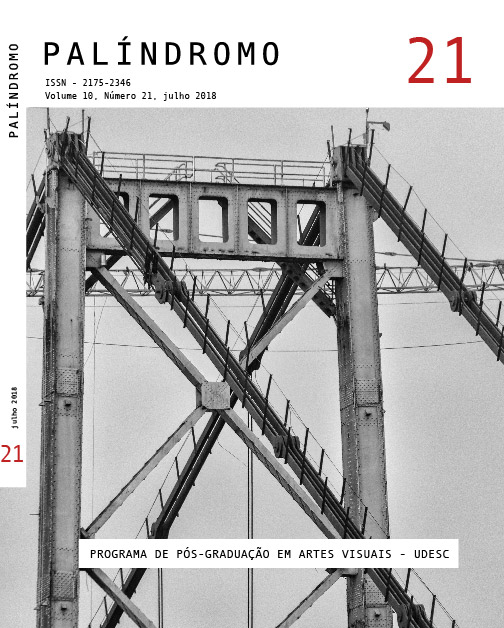HOMO FRAGILIS: LYGIA CLARK AND THE HETEROTANATOGRAPHIC CONFESSIONS
DOI:
https://doi.org/10.5965/2175234610212018053Keywords:
Lygia Clark, contemporary art, heterotanatographyAbstract
This article proposes to reflect about the Structuring of the Self, created by Lygia Clark from what Juliano Garcia Pessanha denominates as heterotanatography, a confessional speech in which small and large deaths are printed in the record of the narratives. There seems to be a long legacy transmitted by Lygia Clark in anticipating the works of contemporary artists such as Ana Teixeira, Beth Moysés and Isabela Sielski who thematize memory and the heterotanatographic confessions in the nineties.
Downloads
References
ADES, D. Art in Latin America: the modern era, 1820-1980. Yale University Press: New Haven and London, 1989.
BUTLER, C.; ORAMAS, L.P. Lygia Clark: the abandonment of art, 1948-1988.New York: The Museum of Modern Art, 2014.
CLARK, E. O mundo de Lygia Clark. Plug Produções, 1973. Apresentado em: Mensagens de uma nova América: Biografia da vida urbana: Jornada da adversidade.
ª BIENAL DO MERCOSUL: Salas do Tesouro, Memorial do Rio Grande do Sul. Porto Alegre RS, 23 out. 06 dez. 2015.
CLARK, L.; Oiticica, H. Cartas: 1964 – 1974. Rio de Janeiro: UFRJ, 1996.
_____. Nostalgia of the body. In: KRAUSS, R. (et.al). October: the second decade, 1986-1996. Cambridge, Massachusetts: London, England: The MIT Press, 1997.
De MARTINO, M. Narrativas do eu: confissões na arte contemporânea: o corpo com diário. Porto Alegre, 2009. 218 f. Tese (Doutorado em Artes Visuais) – Programa de Pós-Graduação em Artes Visuais, Universidade Federal do Rio Grande do Sul.
FARIAS, Agnaldo. Arte brasileira hoje. São Paulo: Publifolha, 2008.
FOSTER, H. O retorno do real: a vanguarda no final do século XX. São Paulo: Cosac Naify, 2014.
GOLDSTEIN, L. Raging in tongues: confession and performance art. In: GAMMEL, Irene. Confessional politics: women’s sexual self-representations in life writing and popular media. Southern Illinois University Press, 1999.p.99-116.
GULLAR. F. Neoconcretismo: intercâmbio de ideias. Concretos paralelos.19.11.2012. Disponível em: www.concretosparalelos.com.brp=987 . Acesso em: 20.03.2016.
_____. Rua Prado Júnior, 16. Folha de São Paulo. 15, maio, 2015. Disponível em: HTTP://www1.folha.uol.com.br/colunas/ferreiragullar/2016/05/177. Acesso em 15, maio, 2015.
HIRSZMAN, M. A relevância de Lygia Clark. Revista Pesquisa FAPESP. n.221, julho, 2014. Disponível em: revistapesquisa.fapesp.br/2014/07/15/relevância-de-Lygia-Clark. Acesso em: 03 de fev.2016.
HORRIGAN, B.; LANGE, J;VENÂNCIO FILHO, P ET al. Cruzamentos: contemporary art in Brazil.Ohio: Wexner Center for the Arts, 2014.
KLINGER, D. Escritas de si, escritas do outro: o retorno do autor e a virada etnográfica. Rio de Janeiro: 7Letras, 2012.
MOYSÉS, B. Sem Título. Folha de São Paulo. São Paulo. 19 dez. 2004. Caderno Mais! p.8.
MELENDI, M.A. Antimonumentos: estratégias da memória (e da arte) numa era das catástrofes. In: SELIGMANN-SILVA, M. Palavra e imagem: memória e escritura. Chapecó: Argos, 2006.
PANOFSKY, E. O significado nas artes visuais. São Paulo: Perspectiva, 2002.
PESSANHA, J. Sabedoria do nunca. São Paulo: Atelier Editorial, 2006.
_____. O autor. Disponível em: HTTP://julianogarciapessanha.com.br/o-autor/. Acesso em: 02 de dez. 2015.
ROLNIK, Suely. Politics of flexible subjetictivity the event work of Lygia Clark. In: SMITH, Terry; ENWEZOR, Okurei; CONDEE, Nancy (eds.). Antinomies of Art and culture: modernity, postmodernity, contemporaneity: Durham, NC: USA: Duke University Press, 2008. P. 97-112.
SELIGMANN-SILVA, Márcio. O local da diferença: ensaios sobre memória, arte, literatura e tradução. São Paulo: editora 34, 2005.
SENNET, Richard. O declínio do homem público: as tiranias da intimidade.São Paulo: Companhia das Letras, 1988.
SIELSKI, Isabela. Memórias compartilhadas. Florianópolis: Museu de Arte de Santa Catarina, 2013. Catálogo de exposição.
TEIXEIRA, Ana. Escuto histórias de amor: diversos países: 2005-2012. Disponí-vel em: http://www.anateixeira.com/historias.htm. Acesso em: 25 dez. 2014.
WEINTRAUB, Linda. In the making: creative options for contemporary art.USA: Zzdap publishing, 2003.
WINTER, Jay. A geração da memória: reflexões sobre o ‘boom da memória’ nos estudos contemporâneos de história. In: SELIGMANN-SILVA, Márcio. Palavra e ima-gem: memória e escritura. Chapecó: Argos, 2006.
Downloads
Published
How to Cite
Issue
Section
License
Copyright (c) 2018 Palíndromo

This work is licensed under a Creative Commons Attribution 4.0 International License.
COPYRIGHT STATEMENT
The articles published by the magazine are free to use, intended for academic and non-commercial applications. Copyright is all assigned to the magazine. The articles whose authors are identified represent the expression from the point of view of their authors and not the official position of Palíndromo Magazine. The author (s) commits to whenever they publish material referring to the article published in Palíndromo mention this publication as follows:
This article was originally published by Palíndromo magazine in its volume (place the volume), number (place the number) in the year of (place the year) and can be accessed at: http://www.revistas.udesc.br/index.php/palindromo


